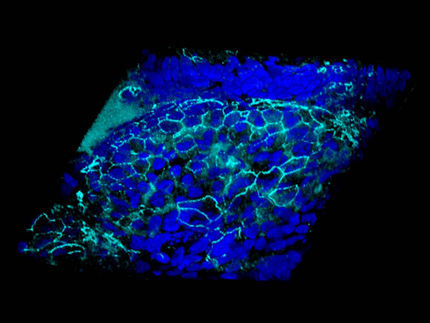HIV-derived antibacterial shows promise against drug-resistant bacteria
A team of researchers at the University of Pittsburgh has developed antibacterial compounds, derived from the outer coating of HIV, that could be potential treatments for drug-resistant bacterial infections and appear to avoid generating resistance. These new agents are quite small, making them inexpensive and easy to manufacture. The research was published in the June 2013 issue of the journal Antimicrobial Agents and Chemotherapy.
The first of many probable applications will likely be the chronic bacterial infections in the lungs of cystic fibrosis patients "that frequently develop resistance to all standard antibiotics, and are the leading cause of death in these patients," says senior author Ronald Montelaro.
The lead compound shows powerful antibacterial activity against clinical isolates of diverse pathogenic bacteria that are resistant to most antibiotics. These agents, called engineered cationic antimicrobial peptides (eCAPs) "may be applicable to treatment of other respiratory infections, topical infections, and systemic infections," says Montelaro.
The genesis of the new agent was basic research on HIV envelope protein structure and function, says Montelaro. As part of this research, "we identified highly conserved unique protein sequences that were predicted by computer modeling to assume structures characteristic of natural antibacterial peptides. Since antibacterial peptides specifically target and disrupt the integrity and function of bacterial membranes, we thought that these similar peptide sequences in the HIV envelope protein might contribute to toxicity and death in infected cells by altering cell membranes."
The team engineered the original HIV peptides for greater effectiveness and smaller size, the latter to reduce manufacturing expenses. The engineering involved modifying amino acid content (they contain just two different amino acids), peptide length, charge, and hydrophobicity. The current paper describes the third generation peptides. The lead agent contains just 12 amino acid residues.
"Another potential application is biodefense, where eCAPs may be used as a rapid postexposure aerosol treatment in individuals after exposure to aerosolized pathogens, where the goal of immediate treatment would be to rapidly reduce bacterial dose from a lethal to a nonlethal or subclinical level," says Montelaro.
Other news from the department science
These products might interest you

Hahnemühle LifeScience Catalogue Industry & Laboratory by Hahnemühle
Wide variety of Filter Papers for all Laboratory and Industrial Applications
Filtration Solutions in the Life Sciences, Chemical and Pharmaceutical Sectors

Hydrosart® Ultrafilter by Sartorius
Efficient ultrafiltration for biotech and pharma
Maximum flow rates and minimum protein loss with Hydrosart® membranes

Hydrosart® Microfilter by Sartorius
Hydrophilic microfilters for bioprocesses
Minimal protein adsorption and high flow rates

Sartobind® Rapid A by Sartorius
Efficient chromatography with disposable membranes
Increase productivity and reduce costs with fast cycle times

Sartopore® Platinum by Sartorius
Efficient filtration with minimal protein adsorption
Reduces rinsing volume by 95 % and offers 1 m² filtration area per 10"

Polyethersulfone Ultrafilter by Sartorius
Reliable filtration with PESU membranes
Perfect for biotechnology and pharmaceuticals, withstands sterilisation and high temperatures

Polyethersulfone Microfilter by Sartorius
Biotechnological filtration made easy
Highly stable 0.1 µm PESU membranes for maximum efficiency

Get the life science industry in your inbox
By submitting this form you agree that LUMITOS AG will send you the newsletter(s) selected above by email. Your data will not be passed on to third parties. Your data will be stored and processed in accordance with our data protection regulations. LUMITOS may contact you by email for the purpose of advertising or market and opinion surveys. You can revoke your consent at any time without giving reasons to LUMITOS AG, Ernst-Augustin-Str. 2, 12489 Berlin, Germany or by e-mail at revoke@lumitos.com with effect for the future. In addition, each email contains a link to unsubscribe from the corresponding newsletter.
Most read news
More news from our other portals
Last viewed contents
Algeta announces first US patient randomized in ALSYMPCA phase III study at Tulane Cancer Center, New Orleans

Parsum GmbH - Chemnitz, Germany
Oil dispersants can suppress natural oil-degrading microorganisms
U of M researchers discover how a brain hormone controls insect metamorphosis - Discovery offers opportunity to develop new environmentally safe ways to control pests
A lab rat - created in the lab - Tel Aviv University is bioengineering tissues as an alternative to animal testing


















































